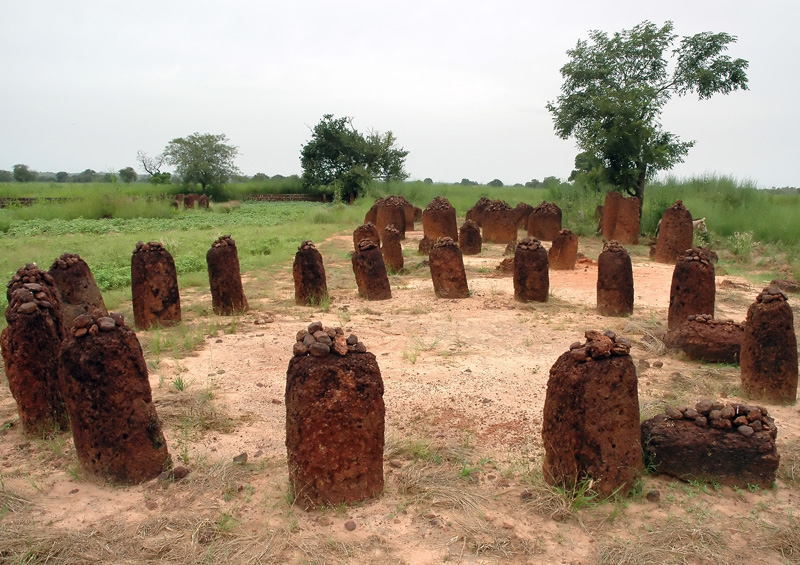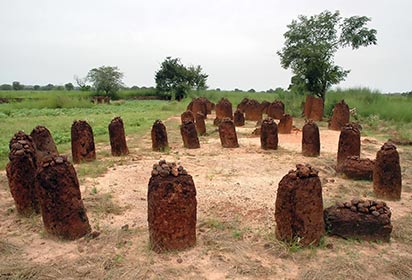Written by Philip Briggs
While some assert that the stones were set in place at the beginning of time by the gods, others regard them as burial markers left by an ancient race of kings and/or giants, and others still believe they are the petrified remains of disgraced people.
The rivers Gambia and Sine-Saloum (in Senegal) form the southern and northern boundaries of a region scattered with some 30,000 carved stelae arranged into neat circles at several hundred individual megalithic sites. These ancient stone circles, each one reminiscent of a miniaturised Stonehenge, form one of Africa’s most enigmatic and intriguing archaeological relicts. And though seldom visited and little known to the outside world, they received an overdue boost when four of the most important individual fields – Wassu and Ker Batch in The Gambia and two others across the border in Senegal – were inscribed as a UNESCO World Heritage Site in 2006.
The stelae of Senegal and Gambia were hand-carved from iron-rich lateritic stones. Most take a simple cuboid or cylindrical shape, but there are also a few impressive lyre-shaped examples, and some are capped with knob-like protrusions that resemble battery terminals. The stones were cut from quarries close to the sites and set vertically into pre-dug pits. Most stones are fairly small, ranging from only 0.75m, but some are much larger at 3m tall.

The number of stones in each circle varies from ten to 24 and the diameter varies from 4m to 7m. Within each stone circle is a slightly domed rise, usually constructed of sand, though a few mounds are topped with lateritic pebbles, presumably to stop erosion. A common feature of many circles is a line of pillars set away on the eastern side. At some sites there are large groups of circles, at others there is only a single circle, while at others still there are no circles at all, only single pillars.
These ancient stone circles, each one reminiscent of a miniaturised Stonehenge, form one of Africa’s most enigmatic and intriguing archaeological relicts.
The discovery of large numbers of skeletons buried below some circles, as well as tools, pottery and miscellaneous ornaments, suggests that these sites are essentially vast funerary complexes. Some of the stone circles seem to mark a mass grave containing bodies thrown chaotically into a pit, perhaps after a battle or an epidemic disease. In other sites it looks as though people were buried alive as sacrifices. Generally the bodies are poorly adorned, often with only a bracelet for decoration and with a weapon, usually a spear, laid beside the body. Sometimes there are also some pottery vessels found by the bodies, usually turned upside-down.
Local oral traditions relating to the erection of the circles are bizarrely inconsistent. While some assert that the stones were set in place at the beginning of time by the gods, others regard them as burial markers left by an ancient race of kings and/or giants, and others still believe they are the petrified remains of disgraced people.
Many people also claim that the circles are the home to spirits, whether benign or evil. However, one point on which all oral traditions do concur is that the megaliths have no cultural link with the region’s present-day Islamic inhabitants. And this much tallies with the archaeological evidence, which indicates that the stone circles are mostly around 1,000 to 1,500 years old.
But archaeological evidence is also curiously inconclusive about the origin of the megaliths. If they are simply funerary markers, then why do the buried human remains found beneath some circles seem to predate their gravestones by several centuries? What happened to the prosperous and well-organised people responsible for erecting the stone circles over several centuries? Were the constructors, as some archaeologists speculate, associated with the royal city of Cantor, which the Arab chronicler El-Bakri reported as lying somewhere south of the medieval empire of Ghana in AD1067? And is it significant that, while no similar memorials exist elsewhere in West Africa, the southern highlands of Ethiopia, at the opposite end of the Sahel, are studded with megalithic grave markers of a similar size and vintage?
We may never know, but part of the fascination of these ancient monuments is the sense of speculation they arouse.
Discover more about The Gambia’s history in our guide to the country:

